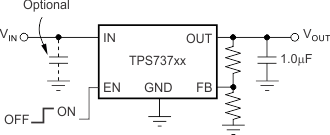SBVS067U January 2006 – September 2024 TPS737
PRODUCTION DATA
- 1
- 1 Features
- 2 Applications
- 3 Description
- 4 Pin Configuration and Functions
- 5 Specifications
- 6 Detailed Description
- 7 Application and Implementation
- 8 Device and Documentation Support
- 9 Revision History
- 10Mechanical, Packaging, and Orderable Information
Package Options
Refer to the PDF data sheet for device specific package drawings
Mechanical Data (Package|Pins)
- DCQ|6
- DRV|6
- DRB|8
Thermal pad, mechanical data (Package|Pins)
Orderable Information
3 Description
The TPS737 linear low-dropout (LDO) voltage regulator uses an NMOS pass transistor in a voltage-follower configuration. This topology is relatively insensitive to the output capacitor value and ESR, allowing for a wide variety of load configurations. Load transient response is excellent, even with a small 1μF ceramic output capacitor. The NMOS topology also allows for very low dropout.
The TPS737 uses an advanced BiCMOS process to yield high precision while delivering very low dropout voltages and low ground pin current. Devices that use the latest manufacturing flow have an updated design with new silicon on the latest TI process technology. Current consumption, when not enabled, is less than 20nA and is designed for portable applications. This device is protected by thermal shutdown and foldback current limit.
For applications that require higher output voltage accuracy, consider TI's TPS7A37 1% overall accuracy, 1A low-dropout voltage regulator.
| PART NUMBER | PACKAGE(1) | PACKAGE SIZE(2) |
|---|---|---|
| TPS737 | DRB (VSON, 8) | 3mm × 3mm |
| DCQ (SOT-223, 6) | 6.5mm × 7.06mm | |
| DRV (WSON, 6) | 2mm × 2mm |
 Typical Application Circuit
Typical Application Circuit